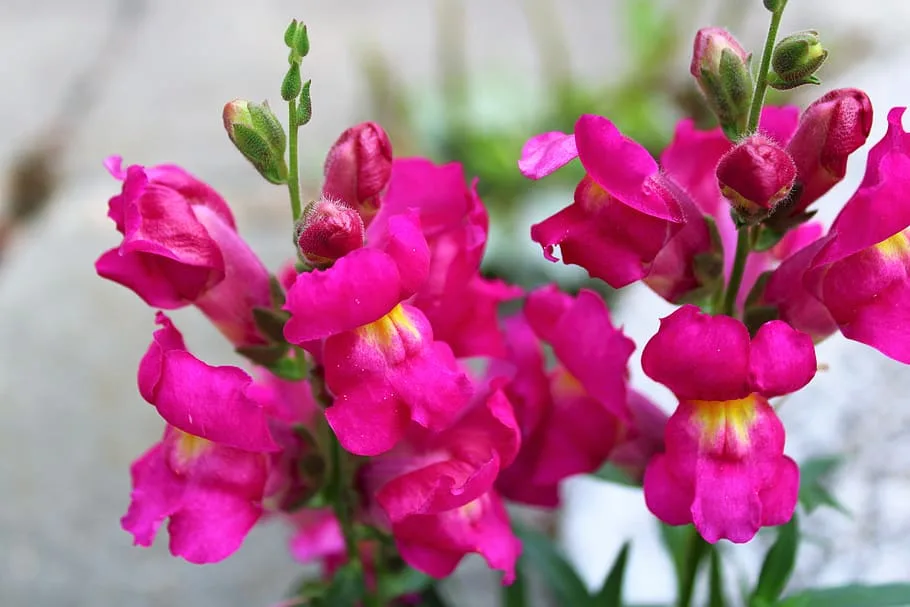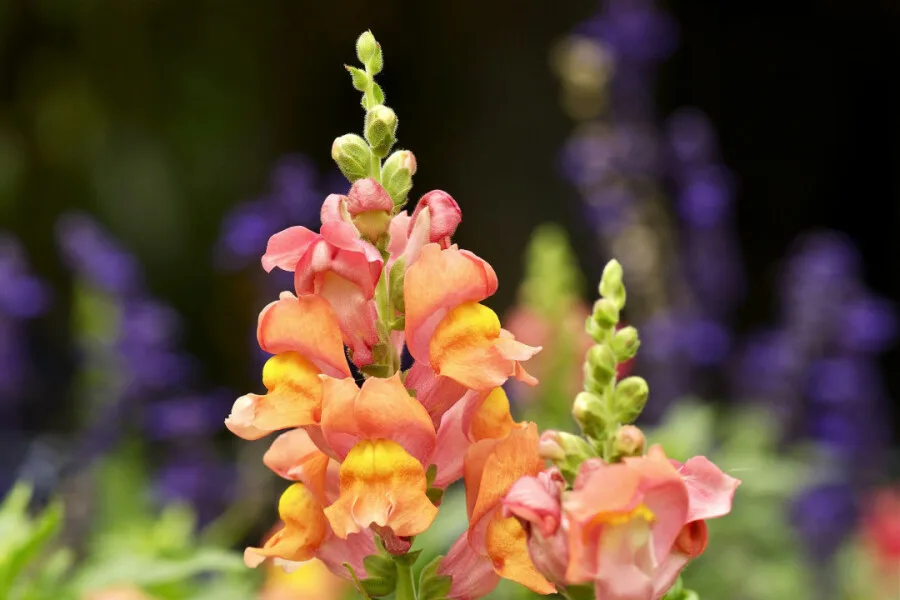Presentation
The Snapdragon is a flower of distinctive elegance that enriches gardens and floral arrangements with its unique appearance. Its vertical trumpet-shaped flowers and varied colors add a touch of sophistication to any space. In this article, we’ll explore the captivating beauty of the dandelion and the symbolic meaning it carries.
The Snapdragon flower, whose scientific name is Antirrhinum majus, is known for its exuberant flowers that resemble open mouths. Originally from the Mediterranean region, this flower has been appreciated for its unique shape and variety of colors, ranging from soft tones to vibrant hues. Its popular name derives from the flowers’ resemblance to a lion’s mouth, and this distinctive feature makes it a popular choice in both formal gardens and floral arrangements.
index
Significance of the Snapdragon Flower
The Snapdragon has a symbolic meaning that goes beyond its aesthetic beauty. Traditionally, this flower is associated with traits such as grace, courage and strength. The shape of the flower, which resembles the open mouth of a lion, is also seen as a symbol of communication and expression. In addition, the lion’s mouth has been used to convey feelings such as affection, friendship and devotion, making it a frequent choice in bouquets and meaningful gifts.
In conclusion, the Snapdragon is a flower that combines visual beauty with a deep symbolic meaning. Its presence in gardens and arrangements not only adds a touch of elegance, but also evokes feelings of grace, communication and affection. By learning more about the Snapdragon, we can appreciate even more its uniqueness and the wealth of emotions it represents.
| Common Name | Snapdragon |
| Botanical Name | Antirrhinum majus |
| Family | Scrophulariaceae |
| Type of Plant | Annual/Perennial flower |
| Adult size | Varies from 15 to 90 cm in height |
| Solar Exhibition | Full Sun to Half Shade |
| Soil Type | Well-drained and fertile |
| Soil pH | Neutral to slightly acidic |
| Flowering Season | Spring to Autumn |
| Color of Flowers | Variety of Core |
| Native Area | Mediterranean region |
| Toxicity | Slightly Toxic |
This table offers detailed information about the Snapdragon flower, including its botanical name, family, growth characteristics, soil and light requirements, flowering time, variety of flower colors, native range and toxicity level.

How to Care for Snapdragon
The Snapdragon is a lovely flower that can add elegance and color to your spaces when grown with the right care. In this section, we’ll cover the main aspects of snapdragon care to ensure that it flourishes in all its beauty.
Adequate light
Light plays a crucial role in Snapdragon’s healthy growth. Place it in a spot with full sun to half shade, where it can receive a few hours of direct sunlight during the day. Make sure it gets enough light to stimulate lush flowering.
Fertile, well-drained soil
Soil is a vital part of growing Snapdragon. Plant it in well-drained and fertile soil, enriched with organic matter. This will help promote healthy growth and prevent water from accumulating around the roots.
Adequate watering
Keeping the soil slightly moist is fundamental to Snapdragon’s success. Water when the top layer of soil begins to dry out, avoiding both too little and too much water. Use watering methods that allow the water to reach the roots deeply.
Ideal Temperature and Humidity
Snapdragon thrives in mild climates. Keep it at temperatures between 15°C and 21°C to ensure healthy growth. As for humidity, avoid excesses that could lead to fungal problems by maintaining moderate humidity.
Adequate fertilization
Providing the right nutrients is essential for Snapdragon’s vigorous flowering. Use a balanced, slow-release fertilizer during the period of active growth, which usually occurs in spring. Follow the instructions on the package to avoid over-fertilization.
By following these care tips, you’ll be well on your way to creating a garden full of beautiful flowers. Remember that constant attention and care are essential to help your plants thrive and charm with their unique beauty.
Types of Snapdragon
A Snapdragon é uma flor que oferece uma gama encantadora de tipos e variedades, cada um com suas próprias cores e formas distintas. Nesta seção, exploraremos alguns dos tipos mais populares de Snapdragon, destacando a diversidade que essa flor única pode oferecer.
Featured Snapdragon types:
- Traditional Snapdragon (Antirrhinum majus): This is the most common type, with its trumpet-shaped flowers and a variety of colors, including shades of pink, yellow, red and white.
- Dwarf Snapdragon: This variety is known for its smaller, compact flowers, making it perfect for flowerbeds and pots.
- Giant Snapdragon: Characterized by its larger and more showy flowers, this variety stands out in gardens and floral arrangements.
- Double Snapdragon: The flowers of this variety have folded petals, creating a unique and full appearance.
- Golden Drip Snapdragon: With vibrant yellow flowers and orange spots, this variety adds a touch of luminosity to gardens.
- Snapdragon Angel Wing: Its delicate white petals resemble the wings of an angel, bringing a touch of serenity to spaces.
- Snapdragon Pendant: With a pendant shape, this variety is perfect for hanging baskets and vertical gardens.
- Snapdragon Variegata: It has variegated foliage, adding extra visual interest to the plant.

Choosing the Right Variety
When choosing between the different types of Snapdragon, take into account the style of your garden, the colors you want to incorporate and the space available for cultivation. The diversity of types gives you the opportunity to create unique and personalized combinations that align with your taste and vision.
The Snapdragon continues to captivate and inspire with its variety of shapes and colors, making it a charming addition to any floral landscape.
Snapdragon: Pruning, Propagation and Planting
The Snapdragon is a flower that can bloom with vigor and beauty when given the right care, including pruning, propagation and correct planting. In this section, we’ll explore the importance of pruning, different propagation methods and a step-by-step guide to successfully planting this elegant flower.
Pruning: Importance and Techniques
Pruning is a crucial practice to encourage healthy growth and lush flowering of the Snapdragon. Here are some reasons why pruning is important:
- Stimulates Flowering: Proper pruning promotes the continuous production of flowers, keeping the plant full of vitality.
- Size Control: Pruning helps to control the size of the plant, preventing it from growing in a disorderly manner.
- Energy Renewal: Removing wilted flowers and dead branches redirects the plant’s energy towards the healthy growth of new flowers.
Pruning techniques for Snapdragon involve removing wilted flowers and dead branches, which can also stimulate the production of new shoots.
Methods of Propagation
Snapdragon propagation can be carried out in various ways, allowing you to grow more plants from a single one. Common propagation methods include:
- Seeds: Collecting mature seeds and planting them in suitable soil is an effective way of propagating Snapdragon.
- Cuttings: Cutting healthy cuttings from the mother plant and rooting them in moist soil is another option for propagation.
Step by step on how to plant
Proper planting is key to Snapdragon’s success. Follow this step-by-step guide:
- Choice of Location: Opt for a location with full sun to half shade, where the Snapdragon can receive the right amount of light.
- Soil Preparation: Prepare well-drained soil enriched with organic matter to provide a healthy environment for the roots.
- Planting: Plant the Snapdragon seedlings or seeds at a suitable depth, following the spacing instructions.
- Initial Watering: Water generously after planting to establish the roots.
- Continuous Care: Keep the soil slightly moist, fertilize during the period of active growth and do regular pruning to stimulate growth.
By following these pruning, propagation and planting steps, you’ll be well on your way to growing a beautiful, lush collection of Snapdragons. The care and attention devoted to these steps will ensure that your plants thrive and adorn your spaces with their unique beauty.

Pests, Diseases and Advanced Care
The Snapdragon is a stunning flower, but just like any plant, it is subject to challenges related to pests, diseases and specific care needs. In this section, we’ll cover the most common pests and diseases, solutions to problems and advanced maintenance tips to ensure your flowers stay healthy and radiant.
Most common pests and diseases
Snapdragon can be the target of various pests and diseases, including:
- Aphids: Small insects that feed on the plant’s sap, causing deformations in the leaves and spreading diseases.
- Caterpillars: They can devour the leaves of the plant, causing considerable damage.
- Mildew: A fungus that manifests itself as a powdery coating on leaves and flowers.
- Rust: Another type of fungus that causes orange spots on the leaves.
- Root rot: Can occur due to excess moisture in the soil.
Common Problems and Solutions
When facing problems with your Snapdragon, consider these solutions:
- Aphids and caterpillars: Use insecticidal soap or neem oil to control infestations.
- Mildew and Rust: Remove affected parts of the plant and apply fungicides.
- Root rot: Improve soil drainage and avoid overwatering.
Advanced Care and Maintenance Tips
For advanced care and maintenance:
- Regular Pruning: In addition to removing wilted flowers, do some light pruning to encourage new growth.
- Thinning: If the plant becomes too dense, thin it out to allow for better air circulation.
- Support: Use tutors to support the stems and prevent breakage in strong winds.
- Crop rotation: Pay attention to crop rotation to avoid soil problems and diseases.
Dealing with pests, diseases and advanced care requires vigilance and knowledge. By being aware of the possible threats and the best maintenance practices, you can keep your Snapdragon flowers healthy and vibrant, ensuring that they bloom in all their splendor.

Curiosities and Myths
The Snapdragon is a flower that not only enchants with its beauty, but also has a number of curiosities and myths that make it even more intriguing. In this section, we’ll explore some fascinating curiosities and interesting myths surrounding this captivating flower.
Curiosities about Snapdragon
- Significant Name: The name “Snapdragon” derives from the shape of the flowers, which resemble the open mouth of an animal.
- Bilabiate flowers: Snapdragon flowers have a bilabiate structure, with two upper petals and three lower petals, giving them a distinctive appearance.
- Variety of Colors: Snapdragon is available in a wide variety of colors, from soft and pastel tones to vibrant and intense colors.
- Part of Tradition: This flower is often used in wedding bouquets and floral arrangements, adding a classic and elegant touch.
Myths and Meanings
- Mythological Origin Legend: According to Greek mythology, Snapdragon emerged from the tears of the goddess Ceres while searching for her daughter Persephone, who had been kidnapped by Hades.
- Symbol of Communication: The shape of the flowers, resembling an open mouth, led to beliefs that the Snapdragon was a symbol of communication and expression.
- Protection against the evil eye: In some cultures, Snapdragon was used to protect against the evil eye and negative energies.
- Good Luck Charm: It was said that carrying a Snapdragon could attract good luck and ward off negative energies.
By learning about these curiosities and myths, you gain a deeper understanding of the Snapdragon and the rich tapestry of stories and meanings that surround it. This flower is not only a visually stunning addition to the garden, but also a reminder of the rich cultural and symbolic heritage that flowers can carry.
Conclusion
The Snapdragon has turned out to be a truly remarkable flower, full of beauty, symbolism and a rich cultural history. In this article, we delve into the journey of this flower, from its presentation and meaning to the delicate care and challenges it can face. With its diverse types, its vibrant colors and its iconic shape, the Snapdragon is more than just a plant; it is a gateway to artistic and emotional expressions that transcend the world of flowers.
When growing Snapdragon, we learn the importance of light, soil, water and the specific care that each stage of cultivation requires. We explore its enchanting varieties and delve into pruning, propagation and planting practices, ensuring that each step is taken with the necessary care to allow this flower to bloom in all its splendor. In addition, we understand the complexity of the pests and diseases that can arise, as well as the solutions and advanced care that can guarantee its health and vitality.
The Snapdragon, with its mythical history, deep symbolism and incomparable beauty, continues to challenge our imagination and enrich our spaces. As you admire its trumpet flowers and the colors that adorn your garden, remember the many lessons this delicate flower teaches us: the importance of patience, attention and respect for nature. May Snapdragon remain a constant reminder that, just like flowers, our lives can blossom into magnificent shapes and shades when nurtured with love and dedication.
Frequently Asked Questions
What types of Snapdragon?
The Snapdragon has several types, including the traditional, dwarf, giant, double, variegated and others, each with unique characteristics in terms of the size, color and shape of the flowers.
How to grow the Snapdragon plant?
To grow Snapdragon successfully, follow these steps:
1.Choose a spot with full sun to half shade.
2.Prepare well-drained, fertile soil.
3.Plant seedlings or seeds in spring.
4.Water moderately, avoiding excess water.
5.Prune lightly to stimulate growth.
How long does the Snapdragon flower last?
The duration of Snapdragon flowers varies, but generally they can last from 1 to 2 weeks in full bloom.
What to look out for with the Snapdragon plant?
To grow Snapdragon successfully, follow these steps:
1.Choose a spot with full sun to half shade.
2.Prepare well-drained, fertile soil.
3.Plant seedlings or seeds in spring.
4.Water moderately, avoiding excess water.
5.Prune lightly to stimulate growth.
What is the Snapdragon plant for?
Snapdragon is often used to:
1.Ornament gardens and flowerbeds.
2.Create floral arrangements and bouquets.
3.Express feelings of grace, affection and communication.
4.Decorate events such as weddings and celebrations.








